Two Trading Posts in Arizona
Index to this page

TheRoute-66.com is reader-supported. When you buy through links on our site, we may earn an affiliate commission at no additional cost to you.
About Twin Arrows, Arizona
Facts, Trivia and useful information
Elevation 5,879 ft (1.793 m). Population n⁄a (2020).
Time zone: Mountain (MST): UTC minus 7 hours. Summer (DST) no DST⁄ PDT (UTC-7).
Twin Arrows is a ghost "town" located on US Route 66 in Coconino County, in the central part of Arizona. It less than one mile west of Toonerville, another abandoned trading post.
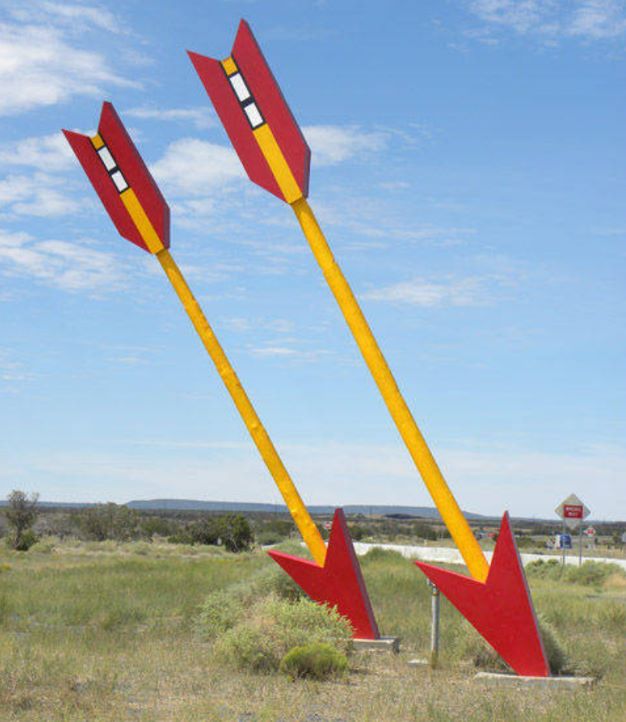
For the early history of Twin Arrows, please see the History of Winslow or Flagstaff, which are both very close to the now abandoned "town" (actually a trading post).
Padre Canyon
The canyon that runs to the west of Twin Arrows is known as Padre Canyon. "Padre", in Spanish means "Father" and it linked to missionaries and the legend of the "Lost Mines of the Padres".
The legend originated during the Spanish Colonial period in New Mexico and it tells about fabulous silver mines in the region that were operated by Franciscan missionaries.
In 1767 they were attacked by Indians en route to their base in Santa Fe, NM and most of the group was killed near neighboring Canyon Diablo ("Devil's Canyon"), but a group of padres survived and reached Santa Fe.

Arizona became a part of the US following the Mexican American War of 1846-48. The wagon roads surveyed by Whipple in 1853 and Beale in 1857 after ran further north, closer to the Little Colorado River.
A shorter route between Flagstaff and Winslow was surveyed in the 1880s, and was chosen by the Atlantic and Pacific Railroad (later acquired by the Atchison Topeka and Santa Fe Railroad) to build the railroad along it.
The railway passed to the north of the modern alignment of Route 66 and I-40 and the station of Hibbard was built to the east of Padre Canyon; a few miles to the west was Angell station followed by Winona.
The land north of present Twin Arrows forms part of the Navajo and Hopi reservations.
The Name: Twin Arrows
It dates back to 1954, and may be a counterpart to the neighboring "Two Guns".
These "Twin Arrows" are surely not the ones fired by Eros, the god of love in Euripides' Iphigenia in Aulis, which in marriage not only bring lifelong content but also ruin and confusion.
In the Middle East, two mantic arrows were consulted when faced with travel problems: "Safr" "go ahead", and "Khadr" "stay put"; their arrangement could tell the traveller what to do.
The Book of Mormon mentions a kind of compass, with two arrows, the Liahona (1 Nephi 16:10) which makes us wonder if the owners of the Trading Post Mormons.
A shorter road than the wagon trail was chosen for automobile highway built by the National Old Trails highway association in the early 1900s. You can see it in this 1921 road map. At that time nothing was built in Twin arrows or Padre Canyon except the now historic bridge, built in 1913. Route 66 was aligned along the National Old Trails in 1926 and traffic began flowing through the region.
The Toonerville trading post was built along Route 66 in the 1930s, and later in the 1950s, the Twin Arrows post was opened further west.

Getting to Twin Arrows
You can reach it very easily along Interstate 40, heading west from Winslow or east from Flagstaff.
Where to Stay
There is lodging on Route 66 in Twin Arrows, a great resort with a casino.
>> Book your Hotel in Twin Arrows.
Lodging Close tor Twin Arrows along Route 66
Heading East In Arizona and NM
- 35 mi. Winslow.
- 68 mi. Holbrook.
- 114 mi. Chambers.
- 164 mi. Gallup.
- 224 mi. Grants.
- 244 mi. Acomita Pueblo
- 301 mi. Albuquerque
You are so close to Las Vegas!
Click on Deals: Opens in new window
Heading West...
- 23 mi. Flagstaff.
- 35 mi. Bellemont.
- 57 mi. Williams.
- 74 mi. Ash Fork.
- 100 mi. Seligman.
- 136 mi. Peach Springs.
- 171 mi. Kingman.
Grand Canyon Hotels
Click on Deals: Opens in new window
>> There is an RV campground close to Twin Arrows
Weather in Twin Arrows
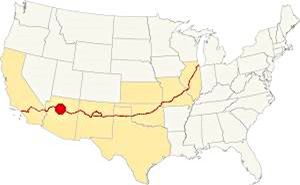
Location of Twin Arrows and Toonerville on Route 66
Twin Arrows ⁄ Toonerville have a climate that is intermediate between the dry and arid Winslow weather and the less dry and more wetter conditions that prevail in Flagstaff. Its rainfall is around 10 inches
(254 mm), snowfall is around 15 inches (38 cm).
The average high temperature in Twin Arrows in summer (July) is 90°F (32°C). The winter (Jan) average high is 42.5°F (5.8°C). The average low in summer is 50.9°F (10.5°C) and in winter it is 17.3°F, well below freezing (-8.2°C).
It is sunny in Twin Arrows, it only has 55 days each year with precipitation.
Tornado risk
There are no tornados in Twin Arrows. As it is located to the west of the Rocky Mountains it has no tornado events at all.
Tornado Risk: read more about Tornado Risk along Route66.
Map of Route 66 in Twin Arrows, AZ
Map showing Route 66 alignment through Twin Arrows (Toonerville)
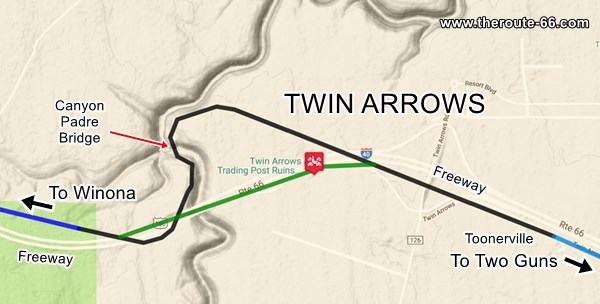
Click on Map to Enlarge
The map above shows US 66 alignment through Twin Arrows - Toonerville. In Pale Blue is the driveable 1926 to 1952 Route 66 alignment. Black shows where there is no road to drive, but you can still make out the original roadbed (1926 - 1937). In Green is the alignment from 1937 to 1952 through Twin Arrows and westwards, now under I-40. Blue shows the 1926 to 1952 alignment of Route 66 west of Canyon Padre and all the way into Winona.
Missing Segments Map
There were several alignments at Winona. And many gaps that no longer exist. You can see them in our custom map with the missing segments of Route 66 in eastern Arizona, including Twin Arrows.
Visit our Route 66 Map of Arizona webpage with the complete alignment and all the towns along it in the state of Arizona.
To drive the old (1926 - 1960) Route 66 alignment in Toonerville and Twin Arrows (a 2.2 mile segment) see this Toonerville - Twin Arrows US 66 map.
Below is a photograph showing Toonerville post (upper red arrow) and the original US 66 roadbed (lower red arrow). Bushes and weeds grow through the cracks in the paving. Trees line it to the left and a fence to the right.
The original Route 66 at Toonerville
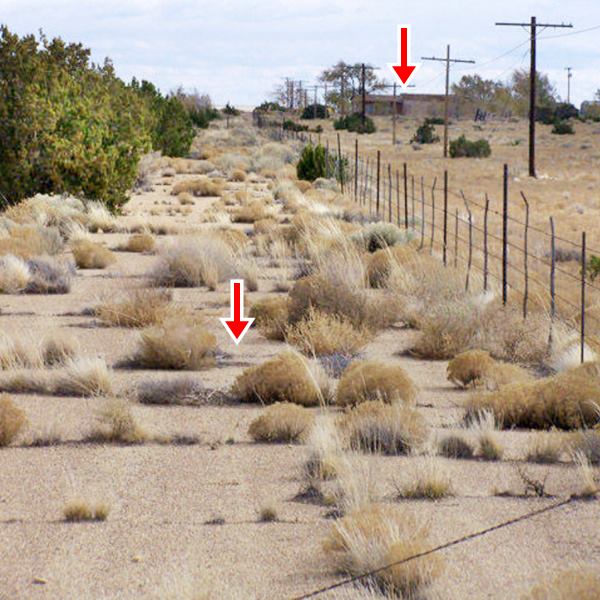
This segment is shown in our Toonerville Route 66 map, the red arrows mark the original alignment.
Route 66 Alignment near Twin Arrows
With maps and full information of the old roadway.
- Winona to Williams (next)
- Winslow to Winona (Twiin Arrows')
- Lupton to Winslow (previous)
Sights and Attractions in Toonerville & Twin Arrows
Things to Do and Places to See
- In Twin Arrows and Toonerville (below)
- Tours & Itineraries
Ghost towns on the Canyon Padre
The historical Route 66 sites of Toonerville and Twin Arrows are now almost ghost towns, with empty derelict trading posts on the old Route 66 alignment.
Historic context: the classic Route 66
Jack DeVere Rittenhouse published his "A Guide Book to Highway 66" in 1946 and it describes the Mothe Road just after World War II, capturing its classic landmarks. It gives us a clear impression on what Route 66 was like at that time. Rittenhouse does not mention Twin Arrows (it was built after 1946), he does however mention Toonerville. Let's see what he had to say:
After crossing the bridge over Canyon Diablo (at Two Guns), there is a stretch of 10 miles until reaching Toonerville. He mentions:
A single building providing gasoline, groceries, and lunches. Rittenhouse (1946)
Rittenhouse also points out that west of Toonerville the Coconino National Forest with its pine trees appears gradually, replacing the dry plains.
He mentions the bridge across Padre Canyon, 2 mi. west of Toonerville and says the canyon is "quite similar to Canyon Diablo". He adds nothing more until reaching Winona, 10 miles west of the bridge.
Toonervill and Twin Arrows
Both are names of now defunct Trading Posts, both were located on the east side of the Canyon Padre. The first one was Toonerville, and it is the one mentioned by Rittenhouse in his book, in 1946. Then came Twin Arrows in the late 1940s. The name that remains is the latter, as it was adopted for the neighbouring Navajo Casino Resort.
Sights in Twin Arrows & Toonerville
Use Interstate 40 to get here because the original alignment of Route 66 ends both east and west of Twin Arrows in a dead end as you can see in the Map above. Use the freeway's Exit 219 and head south and reach the Old Route 66 alignment. From here you can head east (towards the left) to Toonerville or west (towards the right) to Twin Arrows. Below we describe both options.
Haunted Toonerville

Obituary of George Earl Tinnin, son of Toonerville trading post owners. Read obituary
It is only 0.5 miles east to Toonerville (Map with directions), this is the Exact location of Toonerville.
The Trading Post builiding is still standing, but now it is a private property, and a home. The original flat-roofed building is still there, and the main office-shop now has a gable roof.
It was built at a key location: the junction of Route 66 with the road from Mormon Lake (28 mi. to the southwest) to Hibbard railway depot in the north.
Elsie May Wells (1911-1999) recalled her pioneer days in the area after she married Earl Lorenzo Tinnin (1904 - 1972). They first leased "all of a small place called Two Guns", and later they moved to Padre Canyon, where, in her words:
we received permission for the name from the man who wrote the comic strip Toonerville Trolley.
Elsie May Tinnin [1]
We bought sheep and cow hides, wool, rugs and took pawn jewelry for groceries, gas, oil, and other things. Later we built a curio shop and and lunch counter.
I learned to speak the Navajo language quite well as our place was half a mile off mile off the reservation on old Highway 66. We had a good business and friendship with the Indian people.
Death strikes Toonerville in 1947
She added that "most of our happiest days, also our saddest days were spent at our Toonerville home on Old Highway 66."
Her sadness was due to the tragic accidental death, in 1947, of her son George Earl, aged 14 due to self inflicted gun wounds.

1995 Toonerville Stamp. USPS
The Name: Toonerville
The name is quite odd, but has an explanation: the Toonerville Folks was a very popular cartoon published in newspapers between 1908 and 1955. It was first published in the Chicago Post and was syndicated nationally in 1913.
The cartoon focused on a town called "Toonerville" and its trolley operated by "The Skipper." In 1995 the US Postal Service issued a stamp to honor it -and other newspaper comic strips.
It is likely that the Tinnins chose a familiar name that would inspire a cheerful mindset in his potential customers, and a cartoon did just that (like naming a place "Moe's Tavern" - from the Simpsons- nowadays).
The Tinnings ran the trading post until 1954, when they sold it to Merritt Dow 'Slick' McAlister.
The 1971 murder at Toonerville
This is known as the "cold case 1971 killing". On August 30, 1971 two African American couples hit on the Trading Post ran by "Slick" McAlister and his wife Perl.
They robbed the place, murdered Merritt and shot his wife in the head, but she fortunately survived.
The killers were never caught. The 70's had their quota of violence.
And tragedy strikes again at Toonerville
On Nov. 17, 2016, death hit Toonerville again. 55-year-old Mary Smeal awas killed by her 57-year-old partner, Jreffery Jones, who then committed suicide. Both died from gunshot wounds. [5]
Mary was a member of the "Historic Route 66 Association of Arizona member", and worked hard on the preservation project at Twin Arrows, she had rescued one of the arrow's feathers, hand painting them to match the original colors.
She lived at Toonerville and dreamed of restoring it too.
Pictures of Toonerville as time went by
Toonerville Trading Post in 1940s, it was a Texaco gas station at that time.
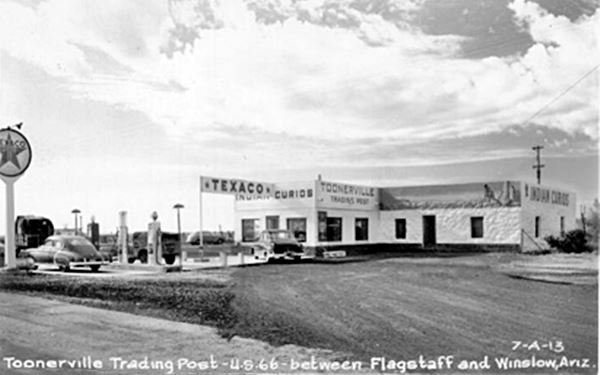
It was, as shown in the photograph, a classic Route 66 Trading Post with whitewashed walls proclaiming its name in capital letters: "TOONERVILLE" and "Cafe - Cold Beer", it also had a mural on the upper part of the western part of the building.
Toonerville Trading Post mid 1960s, it was a Shell gas station too.
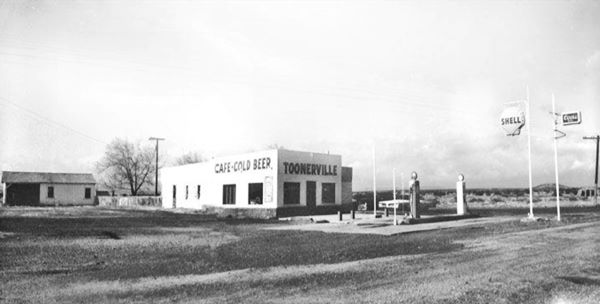
Toonerville Trading Post in 1970s, it was a Conoco gas station then. Notice how the gas pumps have changed in comparison to the previous photo.
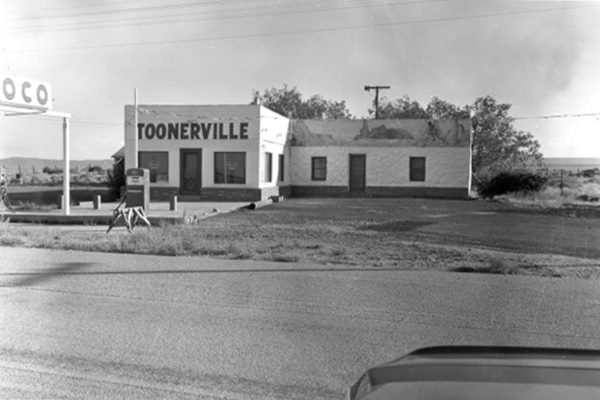
How Toonerville Trading Post looks nowadays
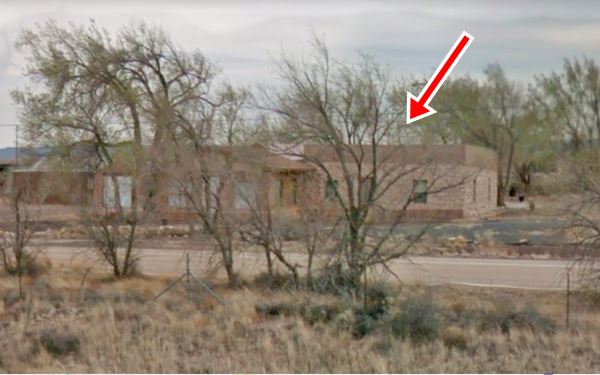
Drive west to visit Twin Arrows.
Twin Arrows
Only 0.6 miles west of Exit 219 along Old Route 66. See this Map with Directions.
It was originally named the "Canyon Padre Trading Post", after the Canyon just west of it.
History of Twin Arrows Trading Post
William Lovell Savory (1916 - 1991) was born in Ohio. His family moved to California in the 1930s, where he married Sudie Foster in 1944.
In 1945 they began building a Trading Post on a plot of 10 acres of land they leased from the state of Arizona, they were going to call it "Twin Arrows Trading Post". They were beset financial difficulties and the post remained unfinished. [2]
They sold it to F.R. 'Ted'Griffiths who ran it with his wife Jewel and named it "Canyon Padre Trading Post" (transposing the words of the canyon's name - Padre Canyon). They sold Mobile gasoline and also had a Valentine Diner. But Ted, while weeding beside US 66 outside of the post was hit by a car. Due to his injuries he sold out to the Troxells in 1955.
Canyon Padre Trading Post in the early 1950s
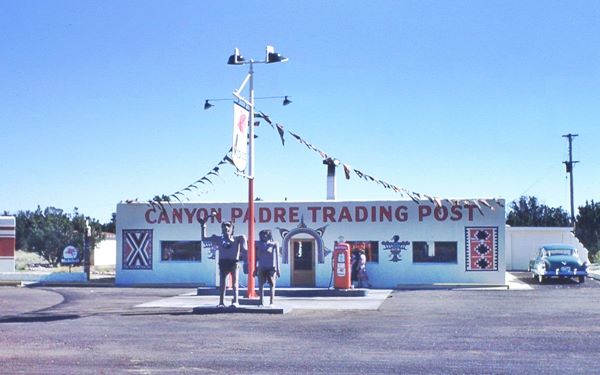
Jean and William Troxell renamed it the Twin Arrows Trading Post and ran it between 1955 and 1985.
Margaret Jean Troxell (1919 - 2017), met her husband W.H. 'Trox' Troxell in University, in her home town of Dubuque, Iowa. They moved to Flagstaff, Arizona in 1942. Trox enlisted during WWII and after the war opened a Photographic sound equipment store.
Jean's parents Levi 'Max' and Edna Maxwell lived on the premises and managed the trading post. Jean commuted daily from Flagstaff.
Despite the fact that I-40 bypassed it, the nearby Exit ensured a constant flow of visitors.
The Twin Arrows Sign
The classic "Twin Arrows" sign made from two telephone poles. Teddy Grooms, great grandson of Lovel Savory (original owner of the place) wrote [3] that "My grandfather and great grandfather (William lovell Savory and William Lovell Savory Jr.) built and installed them from what I understand. They were built at his welding school ⁄ fabrication shop in Tucson".
The shafts were made from telephone poles, and the arrow heads and fletching were made from wood. The following image, from the late 1950s seems to show only one arrow. The shaddow is long and single, and there is only one arrow in the image (red box shows it enlarged). Was the second arrow placed separately? Further west? on the eastern side of the trading post?
Late 1950s air view of the Twin Arrows Trading Post
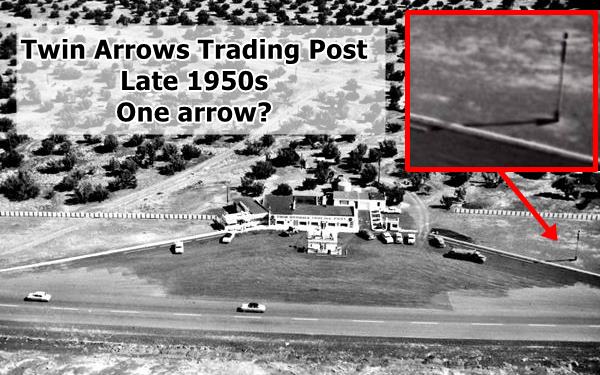
Unable to buy the land from the state, and not making enough money despite the sign proclaiming Twin Arrows as "the Best Little Stop on I-40", the store closed in 1990, reopened shortly in 1995 but later shut for good. The Hopi tribe now owns the buildings and the arrows but not the land. Togethter with Route 66 volunteers, the Hopi restored the arrows and the building in 2009, but the site is still closed and slowly falling apart, covered with graffiti. [4]
When it was in good shape.
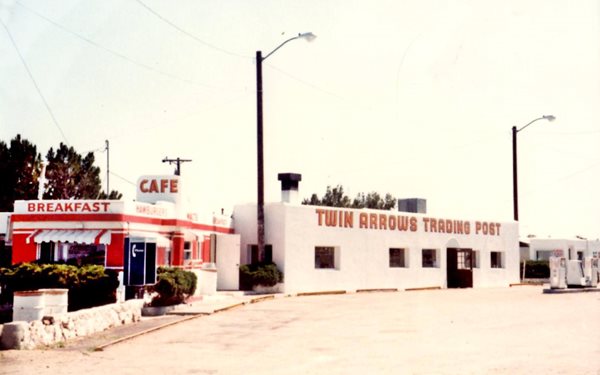
Twin Arrows nowadays, with its Valentine Diner and "Cafe" sign.
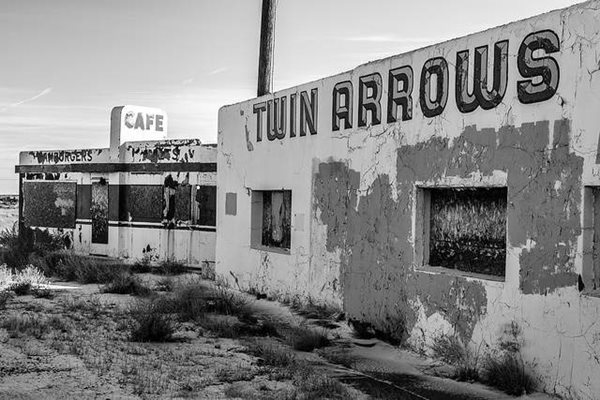
Valentine Diner
There are other Valentine diners on Route 66, for instance the restored Valentine Diner at Edgewood, NM, the Winslow Arizona Valentine or the Albuquerque Valentine Diner Police Substation.
A Diner is a classic example of Route 66 "Americana" (More on Americana). Diners were prefab restaurants, defined as "a restaurant shaped like a railroad car", the name derives from "dining car".
The Valentine diner at Twin Arrows was one of at least 2,000 diners built by the Valentine Manufacturing Company of Wichita, Kansas. They were prefabricated, ready-to-use mobile diners which came with all the fittings (stools, tables and counters) plus a kitchen area. They were available in different sizes and models.
They were invented by Arthur Valentine (1891 - 1954) who began producing them in 1947. After good growth during the 1950s, the company gradually lost business in the 1960s and folded in 1975. The growing fast food chains and suburbia had displaced the small diners and drove them to extinction.
Forest Gump at Twin Arrows
The "invention of the smiley face" scene in Forrest Gump (1994) was filmed at Twin Arrows. See the video clip of this scene.
Still from Smiley scene of Forrest Gump filmed in Twin Arrows.
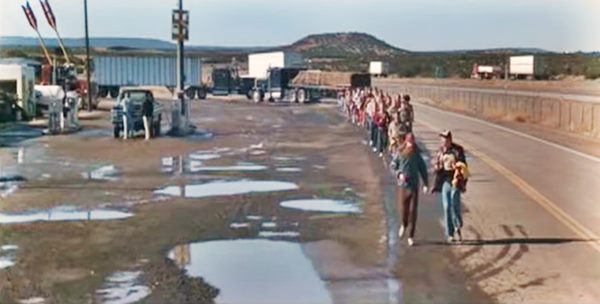
Wilson Sinagua Pueblo

Map showing ruins of Wilson Pueblo, USGS 1968
The "Sinagua" (Spanish words for "without water") people lived in this area near the San Francisco Peaks in the Little Colorado River basin. They were hunter gatherers and farmers, and grew beans, squash, and corn. They flourished between 500 and 1220 AD until a drought pushed them into New Mexico. By the 1400s they had vanished.
There is a Sinagua site half a mile to the North West of Toonerville (Next to the Casino), it is known as "Wilson Pueblo" (NA 1139) it dates back to around AD 1150. It was it was excavated by Wilson (1929), Hargrave (1930), and Colton (1946) and has produced pottery shards. It is a five-room masonry structure built over an earlier structure. Location Map (private property).
This section of your Route 66 road trip ends here, drive west into the next town, Winona, and consider visiting the Grand Canyon
Below are some tours close to Twin Arrows.
Tours & Itineraries Near Twin Arrows and Toonerville
Heading west from Twin Arrows towards Winona, the countryside changes and small pine trees and junipers appear dotting the now vanishing desert. The road climbs into the Arizona Plateau, a table-land which rises all the way to Flagstaff, and the scenery becomes forested.
To the west you can now clearly see the snow capped summits of volcanic San Francisco Peaks around Flagstaff. These are relatively young volcanoes (6-million-years-old) and the highest one is Humphreys Peak which is the highest point in the state of Arizona (12,633 ft - 3.853 m).
Route 66 Canyon Padre Bridge

Looking East along the deck of the bridge. Sean Evans
Old Route 66, Twin Arrows, AZ.
Listed in the National Register of Historic Places
This centennial bridge (built in 1914) spans the Padre Canyon gorge at Twin Arrows and carries the original Route 66 alignment across it.
The bridge is a concrete Luten arch bridge with cantilevered roadway (Daniel Luten patented this strong yet light type of bridge). The deck is concrete over an earth fill. It is 148 feet long and has a 125 ft. span (45.1 and 38 m). It cost $ 7,900 which adjusted for inflation is $188,375 of nowadays.
It is 12 years older than Route 66 because it was built on the National Old Trails highway (or Arizona Santa Fe highway). When Route 66 was aligned through the area in 1926 it adopted the course of the National Old Trails roadbed.
It is now on the abandoned grade of U.S. 66, which was replaced in 1937 when the paved road was built with a straighter course now under I-40's roadbed west of the Twin Arrows post. The new alignment avoided the dangerous curves that approached the old bridge. Now it is used for local Navajo traffic.
Reaching the Bridge
The bridge is located here (Map showing Exact Location of the Bridge).
The Route 66 bridge crosses Canyon Padre with a north to south direction. It is very close to Exit 219 at Twin Arrows, but cannot be reached from the east because its access road is in private property. You can reach it from the west, driving to Winona and returning towards Twin Arrows along AZ-394. This Map with directions shows how to reach the area next to the bridge from Winona.
But it does not take you all the way to the bridge, 6.8 miles east of Winona, it becomes a rough and tricky dirt track and a regular car cannot cope with it. You will have to walk the last part of the road, roughly one mile as the road curves northwards towards the bridge.
Twin Arrows Navajo Casino Resort
22181 Resort Blvd, Flagstaff, AZ 86004. Website: http://twinarrows.com/
Located on the north side of I-40's Exit 219, it is a Navajo casino complex with adjacent hotel, multiple dining rooms, table games and slots.
VIsit the Grand Canyon
Tip: consider visiting the Grand Canyon on your Road Trip.
Some tours and sightseeing
>> You can Book a Room at the Grand Canyon Railway Hotel in Williams
Grand Canyon National Park
World Heritage site of UNESCO


Some sponsored content
>> Book your Hotel in Twin Arrows


Credits and Further Reading
Banner image: Hackberry General Store, Hackberry, Arizona by Perla Eichenblat
Larry Hendricks, Cold Case Close-up. File: Merritt "Slick" McAlister (1971). Arizona Daily Sun, January 09, 2014
Will Croft Barnes, Arizona Place Names, University of Arizona Press, 1988.
Jack DeVere Rittenhouse, (1946). A Guide Book to Highway 66.
Bill and Ruth Wells, 1980, The Hilary Mercer Wells Cochise County Bunch: A Compilation of Fond Memories
Foster-Savory Collection North Arizona University
Twin Arrows Trading Post Facebook
Hopi hope to reopen restored I-40 rest Stop
Coconino Sheriff's Office investigating possible murder suicide, Arizona Daily Sun



